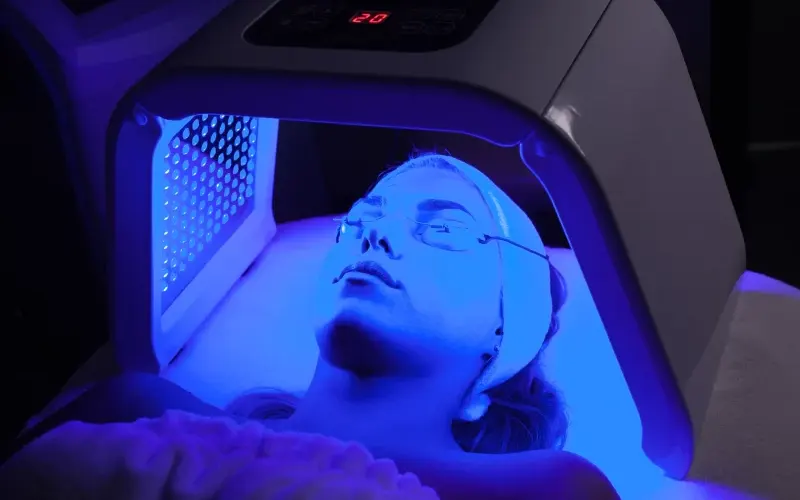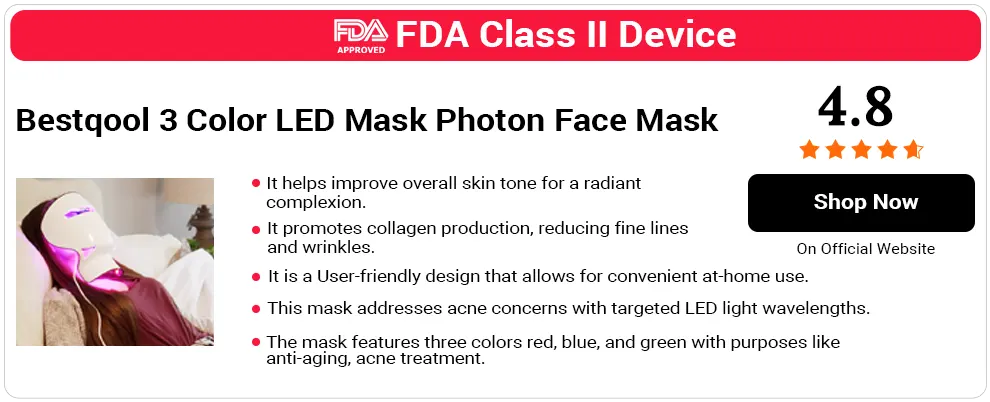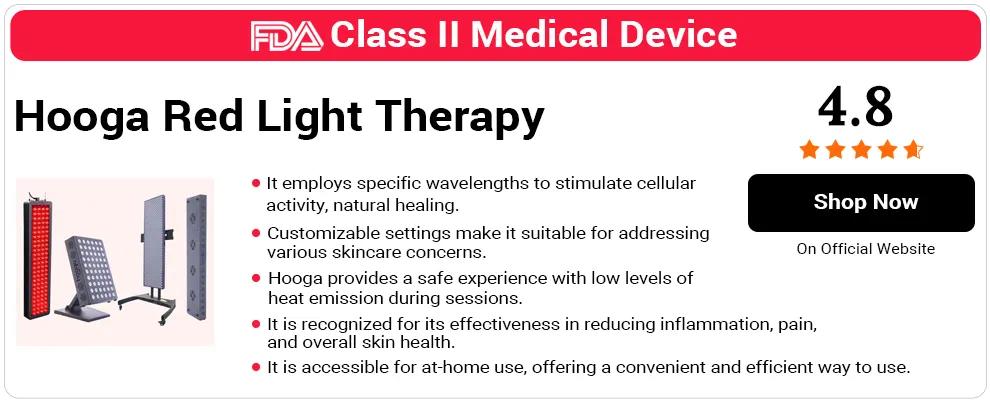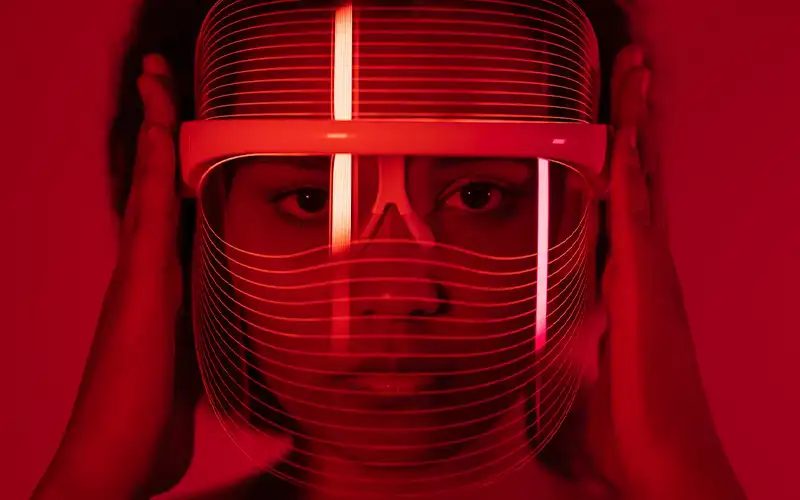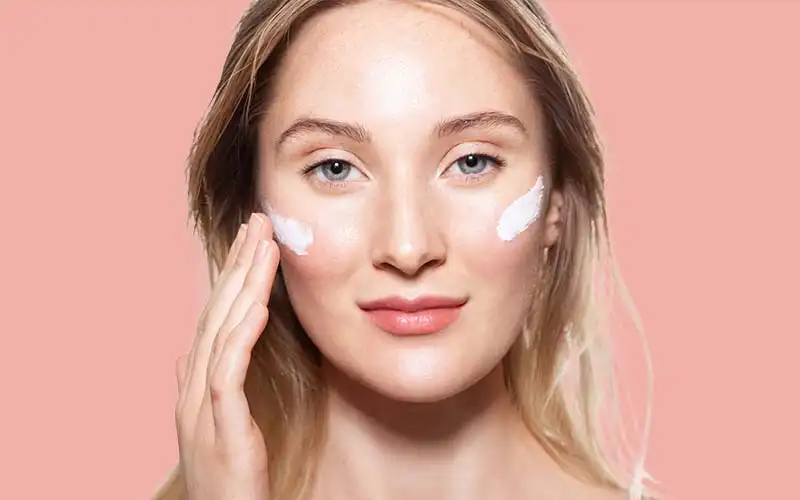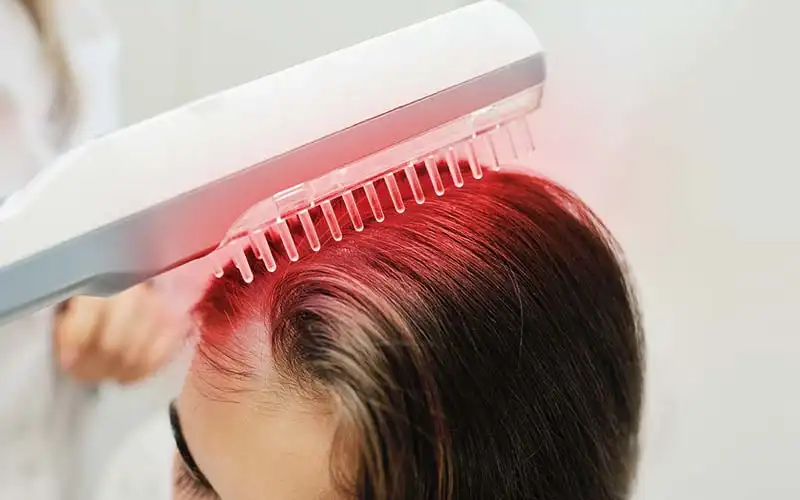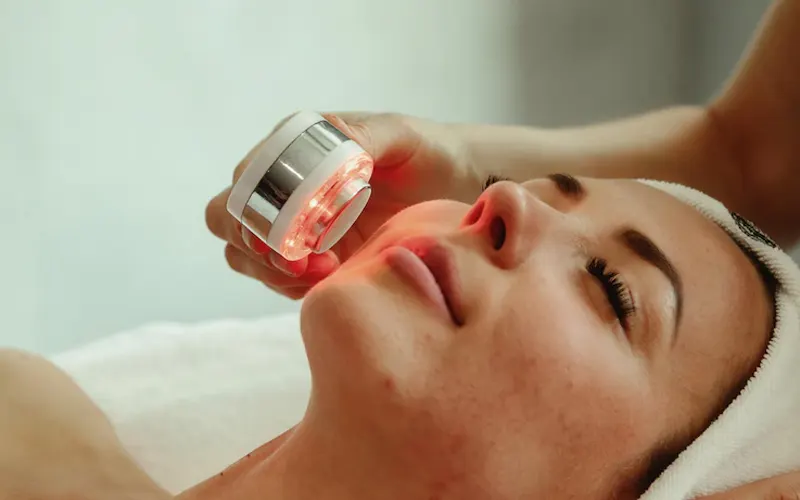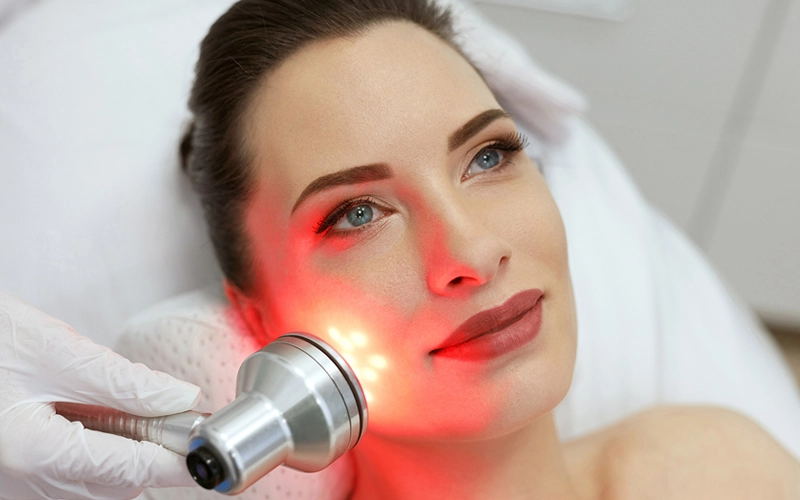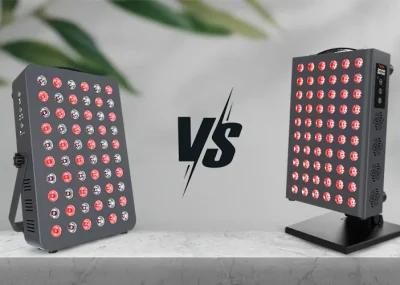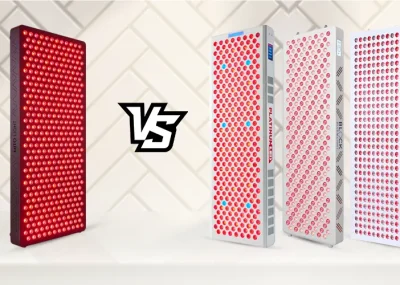Overview
No doubt you’ve heard of blue light, as it’s emitted from most of the common devices and technology we use in our day to day lives. Its use in LED light therapy has grown in recent years making it almost as popular as red light as a treatment modality.
Blue light therapy came into common usage due to research showing its benefits for many aspects of health, like acne treatment, improving mood, enhancing oral health, and treating skin conditions.
In this article we’ll give you detailed information about blue LED light therapy, including how it works, its health benefits, how to use it, and some of the best devices on the market for blue light therapy at home use.
What is Blue Light Therapy?
In order to understand blue light we have to look first at the electromagnetic spectrum as a whole, which is the entire range of electromagnetic radiation.
This includes long wavelengths like UV rays, radio waves, microwaves, and infrared light, and short wavelengths like gamma rays and X rays, all of which are invisible to our eyes.
The wavelengths of visible light are somewhere in the middle, and they range from about 380-700nm. Red light spans from 625-700nm, and blue light ranges from 450-495nm.
Sunlight contains quite a bit of blue light, but for more concentrated treatment and health benefits LED light therapy can be highly effective, ideally at an intensity of about 5-10 mW/cm2.
What does blue light therapy do? Benefits of this treatment include boosting serotonin levels for improved mood, decreasing skin inflammation to heal and prevent acne, enhancing cognitive functioning, lowering anxiety, improving dental health, and more.
Let’s look at some of these benefits in more detail, the potential blue light therapy side effects, recommended products, key questions and everything else you’ve ever wanted to know about blue LED light therapy.
Pros and Cons of Blue Light Therapy
Pros
- Blue light therapy benefits the skin by potentially healing and preventing acne.
- It may boost serotonin and improve mood.
- Blue LED light could improve memory and other cognitive functions.
- It may kill bacteria on the mouth to improve oral health.
- Blue LED could treat skin conditions like psoriasis.
Cons
- The treatment may cause (harmless) tingling or prickling on the skin in some users.
- Blue light therapy is not suitable for people who are very sensitive to the sun.
- If you do the treatment in the evening it could disrupt your sleep.
How Blue Light Therapy Works
Blue LED light spans from 450-495mn wavelengths, and the photons of light penetrate the body at a depth of about 1mm. These photons stimulate the mitochondria of your cells, which boosts the synthesis of ATP (adenosine triphosphate).
The ATP provides cellular energy to the entire body, which has a number of health benefits such as blue LED light therapy benefits for skin.
An article by Ralf Jäger, et al in the Journal of Functional Foods discussed the bioavailability of adenosine triphosphate as well as its numerous benefits for health [1].
At a penetration depth of 1mm, blue light therapy for skin is ideal for killing harmful acne-causing bacteria, reducing inflammation, preventing breakouts, shrinking oil glands, and healing wounds, as we explained on our review of the Solawave brand. It’s even more effective when combined with red light.
A 12-week clinical study published in the Journal of the American Academy of Dermatology showed that low level blue and red light therapy effectively healed mild to moderate acne [2].
North Carolina-based board-certified dermatologist Sheel Desai Solomon, MD discussed the use of blue light therapy for acne: “Bacteria can be very susceptible to the blue light spectrum. It stops their metabolism and kills them.
Unlike topical treatments that work to ease inflammation and bacteria on the surface of the skin, light treatment eliminates the acne-causing bacteria in the skin before it begins to feed on the oil glands, causing redness and inflammation [3].”
The benefits of blue light therapy extend beyond the skin into increasing serotonin levels for an improvement in mood, whitening your teeth and improving your dental health, and more, as we will discuss in detail in the next section.
An article by Natallia E. Uzunbajakava, et al published in the Journal of Biophotonics discussed the mechanisms, safety considerations, and other nuances of blue light phototherapy [4].
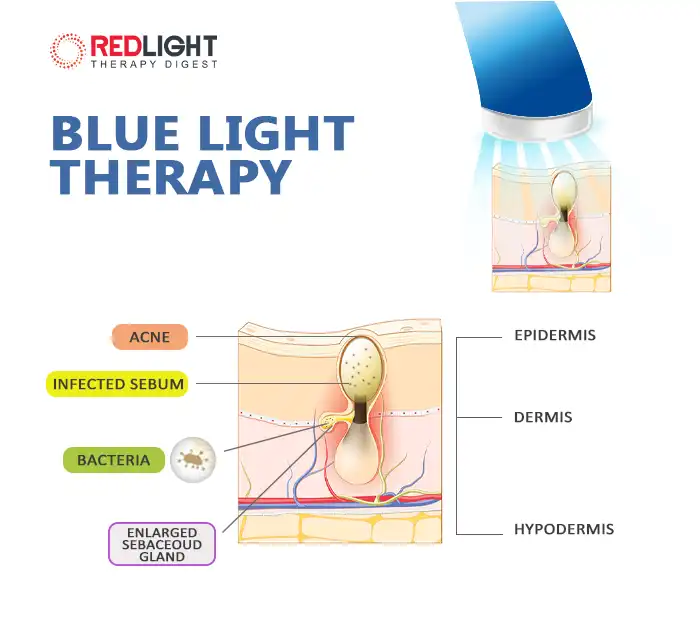
Blue light therapy
What Are the Benefits of Blue Light Therapy?
Blue LED light therapy offers a number of potential benefits based on the existing research. In this section we’ll go through each benefit in detail, examining the studies regarding its efficacy in each area.
1. Heals and Prevents Acne
Blue light therapy is best known for its ability to heal and prevent acne, as it helped to reduce inflammation and kill the bacteria that is at the root cause of the condition. It may also shrink the oil glands and slow the release of sebum, for less of the oily skin that can lead to pimples.
Judith Hellman, MD, New York board-certified dermatologist, explained the results her patients have achieved with blue light LED therapy treatment:
“My patients have experienced a significant decrease in the number of acne lesions, both pimples and cysts, with the home device. Not only have they achieved better skin, there also has been a significant improvement in their self-confidence.
Because most sufferers are young, the success of the treatment and reduction of their acne also helped their social life and interactions with others, both in a personal and a professional setting. I consider this a very big treatment success beyond just improving the condition itself [5].”
When we look at the research, there are studies that support the effectiveness of blue light therapy for acne treatment.
A 7-day study by Michael H Gold, MD and Anneke Andriessen, et al published in The Journal of Clinical and Aesthetic Dermatology concluded that self-applied blue light was effective at healing mild to moderate acne, with a reduction in pustules during treatment [6].
In addition, Anna Chacon says a systematic review of studies published in Nove de Julho University, et al found that Blue light therapy works by killing Propionibacterium acnes, the bacteria that cause acne inflammation. It can penetrate the skin’s hair follicles and pores which harbor this bacteria [7].
RELATED: According to a Dermatologist, How LED Light Therapy Can Transform Your Skin
2. Alleviates Seasonal Affective Disorder
Blue light therapy is not limited to skincare benefits; it has also proven effective in addressing seasonal affective disorder (SAD). SAD is a type of depression that occurs during certain seasons, typically during the winter months when exposure to natural light is limited. Blue light therapy can mimic the effects of natural sunlight, helping alleviate the symptoms of SAD and improving overall mood, claims Taylor Wilson, Certified Recovery Specialist.
The most common treatment for the condition is bright white light which emulates sunlight. While the results of studies and systematic reviews vary somewhat and not all of the research found positive results, there is significant support for the benefits of blue LED light in improving the condition.
In addition, Anna Chacon says a systematic review of studies published in Can J Psychiatry, et al found that blue light therapy can help regulate mood-related chemicals and circadian rhythms, which can improve symptoms of seasonal affective disorder [7].
A study on 24 SAD patients published by Gena Glickman, Brenda Byrne, Carissa Pineda, Walter W. Hauck, and George C. Brainard at Thomas Jefferson University concluded that blue LED light treatment is more effective than red light in treating seasonal depression [8].
3. Alleviates Non-Seasonal Depression
In addition to treating seasonal affective disorder, there’s some evidence that blue light therapy is an effective modality for decreasing non-seasonal depression. However, as of yet there are only animal studies that explore this issue, so scientists will need to conduct human studies to confirm the results.
As for how blue light therapy may alleviate depression, there’s evidence that it increases levels of the key brain neurotransmitter serotonin which plays an important role in mood. We have also covered in our SAD light therapy lamp article, products that help to improve mood and sleep quality.
For example, a study published in the Journal of Neuropathology and Experimental Neurology by Qinghe Meng, et al found that blue light effectively raised serotonin levels and decreased depression in rats [9].
Research published in Frontiers in Psychiatry by Hong Hu, et al on Mongolian gerbils concluded that deprivation of blue light actually induced depression [10].
4. Regulates Your Sleep-Wake Cycle
While exposure to blue light at night may disrupt your circadian rhythm and cause difficulty with sleep, exposure during the day helps set your circadian rhythm, reminding your body that it’s daytime.
It does this by suppressing the production of the hormone melatonin, which the pineal gland in your brain releases when it’s night so you fall asleep. This is why it’s hard to sleep if you have too much exposure to blue light at night, because it blocks melatonin production.
Blue light in the daytime makes you more alert, and may even improve cognitive functioning. An article published in the Journal of Biophotonics by Siegfried Wahl, et al explored blue light and its ability to set the human rhythm [11].
5. Treats Hyperbilirubinemia
Hyperbilirubinemia, also called jaundice, is a very rare condition characterized by excess levels of bilirubin in the blood, which is a pigment produced by the liver.
The high levels can decrease the iron in your body, causing symptoms like nausea, abdominal pain, weakness, fever, chills, fatigue, and possibly chest pain.
The condition often occurs in newborns or very young babies, and there’s some evidence that blue light therapy may effectively treat it.
For example, a randomized controlled trial published in Pediatric Research by Finn Ebbesen, et al on newborns with jaundice concluded that both turquoise and blue light were effective at decreasing levels of bilirubin [12].
6. Quality of Life After Traumatic Brain Injury
While blue light may not heal a traumatic brain injury, there are studies indicating that it can have a positive effects on aspects of life quality like sleep, mood, and even cognitive functioning following such an injury. Let’s have a look at some of the research.
A randomized controlled 6-week trial published in the Journal of Head Trauma and Rehabilitation by Adam C Raikes, et al concluded that 30 minute daily sessions of blue light therapy improved sleep quality, reduced daytime sleepiness, and enhanced quality of life in patients following a mild traumatic brain injury [13].
A similar 6-week study on traumatic brain injury patients published in Neurobiology of Disease by William D S Killgore, et al found that blue light therapy not only improved sleep and decrease daytime fatigue, but it also helped patients to recover some cognitive functioning [14].
In addition, Anna Chacon says a systematic review of studies published in Front Neurol, et al found that blue light therapy can improve the brain’s cognitive function by influencing its circadian rhythms, which can lead to improved sleep and mood.
SEE ALSO: Red Light Therapy for Brain | The Cognitive and Mental Health Benefits
7. Improves Oral Health
Blue light therapy has benefits for dental care, although it’s best to either seek professional treatment or purchase a device which the manufacturer designed specifically for this purpose, like the Novoral Care Pro by NovaaLab.
The potential benefits of blue LED light include its ability to kill harmful bacteria and reduce inflammation. This helps to prevent infections and reduce gingivitis, which is swelling around the teeth.
We found several studies which examine the impact of LED light toothbrushes for decreasing inflammation, killing bacteria, and stopping gum bleeding. For those interested in exploring the benefits further, it’s worth considering our detailed article on the best electric toothbrushes, which covers a comprehensive review of top-rated options and their features.
For example, a randomized controlled study published in the Open Journal of Stomatology by Nadja Bjurshammar, et al concluded that daily brushing with a blue light therapy toothbrush did reduce dental plaque to some extent [15].
There’s some evidence that blue light therapy may help whiten the teeth, however, at the levels required for this to be successful the light could increase levels of oxidative stress which risks damage.
A review published in The Japanese Dental Science Review by Fumihiko Yoshino and Ayaka Yoshida stressed the importance of decreasing oxidative stress during dental treatment [16].
Speak to your dentist prior to doing this, and in many cases you are better off actually getting professional treatment to make sure the dosage and treatment time is safe. Unfortunately there is little human research, so we can’t guarantee the safety of blue light for whitening teeth.
8. Treats Skin Conditions Like Psoriasis and Atopic Dermetitis
In addition to being an effective treatment for acne, there is evidence that blue light therapy may help heal other skin conditions, specifically psoriasis and atopic dermatitis.
Psoriasis
Psoriasis is a skin condition which causes itchiness and hard, scaly patches on the skin, most particularly on the elbows, knees, scalp, and trunk. There’s some evidence that red or blue light therapy for psoriasis may have a positive effect on treatment outcomes. Let’s look at the evidence for blue light.
A research review published in Dermatologic Therapy by Collin Pieper, et al concluded that there is evidence for the efficacy of blue LED light therapy in treating psoriasis and other skin conditions like acne, actinic keratosis, and cutaneous infections [17]
In addition, Taylor Wilson, Certified Recovery Specialist says blue light therapy has shown promising results in treating psoriasis. Psoriasis is a chronic skin condition that causes red, itchy, and scaly patches. Research has demonstrated that blue light therapy can significantly reduce the severity of psoriasis symptoms and improve overall skin quality.
Another study published in the Journal of Comparative Effectiveness Research by Amir Ansaripour, et al found that blue light therapy and pharmacological intervention were equally effective at healing psoriasis, but blue light was the cheaper option [19].
SEE ALSO: Red Light Therapy for Psoriasis and Eczema | A Complete Guide
Atopic Dermatitis
Atopic dermatitis, often referred to as eczema, is a common skin condition which causes symptoms like redness, inflammation, itchiness, and even scaling and cracking. It tends to be a long term issue, usually beginning in childhood, but it can affect people of any age.
The benefits of blue light therapy in decreasing redness, inflammation, and irritation makes it an ideal potential treatment for the condition. What does the research say?
A review of studies published in Life examined the research on the role of blue light in dermatology concluded that it may be effective at healing skin conditions including atopic dermatitis, eczema, and psoriasis [20].
In addition, Anna Chacon says a systematic review of studies published in Life (Basel), et al found that blue light therapy can help reduce inflammation and relieve itching, which can improve the quality of life for people with atopic dermatitis [21].
What is the Treatment Procedure for Blue Light Therapy?
You can get blue LED light therapy treatment in a dermatologists office, or you can purchase an at-home device like one of the Platinum LED Light panels.
The treatment protocol for at-home devices will differ somewhat depending on the product you buy, so it’s important to follow the instructions in the user’s guide carefully before setup and use.
Generally speaking, the treatment recommended for blue light is 20 minute sessions 3-4 times a week, however, it also depends on the issue you are targeting.
Although at 20 minutes a few times a week you are unlikely to incur any eye damage, if you want to be extra careful you may wear protective blue light therapy glasses or goggles during your sessions.
What Is The Difference Between Blue Light And Red Light Therapy?
Red LED light travels at 625-700nm wavelengths and penetrates the skin at 2-3mm, while blue light travels at 450-495nm and penetrates 1mm.
The difference in the wavelengths and depth of penetration leads to different benefits. For example when it comes to the skin, as we explained in our review of the Lumigen, This red light device is better for anti-aging and rejuvenation, while blue light is the best choice for treating acne and other skin conditions.
Red light offers other benefits like improving exercise performance, boosting energy levels, enhancing fertility, and balance testosterone levels.
There’s some overlap in benefits as well, as both blue and red light therapy may improve mood, boost cognitive functioning, and help strengthen the immune system, to give a few examples.
So, when it comes to red light vs blue light therapy, which do we think is best? Blue and red light therapy both have their advantages, depending on the issue you want to treat, but you can also consider using a combination of both to achieve a range of benefits.
Does Blue Light Therapy Have Side Effects?
We can tell you that there are some possible side effects associated with the use of blue light, although many of the potential symptoms like headaches, eye strain, or skin damage only occur with overexposure. If you are carrying out 20 minute sessions a few times a week, these should not occur.
The primary concern with blue light therapy is potential damage to the eyes with overexposure, and the fact that this may increase your risk of developing conditions like macular degeneration, dry eyes, or glaucoma.
The excess blue light may do this by raising levels of oxidative stress, increasing inflammation, damaging the mitochondria, and even promoting cell death. To help avoid this risk, always follow the recommended treatment protocol and do not carry out excess treatment.
Keep in mind that the blue light around you all day from the devices you use exposes you to far more risk than the short LED light treatments a few times a week, which are low risk if you follow the proper guidelines.
As much as blue LED light therapy benefits you during the day by helping to regulate your circadian rhythm, too much blue light at night can disrupt your cycle and cause problems with sleep. To avoid this, simply do not carry out treatments in the evening.
SEE ALSO: Red Light Therapy Side Effects – A Complete Guide
What Safety Practices Should You Follow?
As we’ve said, the most important safety feature is following the treatment protocol exactly as recommended, so you don’t overdo your exposure to blue light. In order to protect your eyes, there are glasses or goggles you can purchase which help prevent damage.
While we’ve extensively covered the benefits and safety measures of blue light therapy, it’s worth mentioning that there’s another color in the light spectrum showing promise in the field of light therapy – green light. Green light therapy has gained attention for its potential benefits, including its ability to enhance mood, reduce chronic pain, and promote wound healing. Although not as widely studied as blue or red light therapy, green light therapy is an emerging area of research that holds exciting possibilities.
It’s important to note that outside of your LED treatments, most of us have exposure to quite a bit of blue light during the day from all of the devices we use and florescent blubs used in many offices and shops.
This overexposure is far longer lasting and more damaging than a 20 minute LED treatment a few times a week. If you want to reduce your risk of blue light damage, try to limit screen time or find other ways to decrease your exposure.
Frequently Asked Questions
Q: How Long Does It Take For Blue Light Therapy To Work?
A: LED light treatment, including with blue light, does not usually produce results in one treatment session. The benefits appear after regular treatments for several days or weeks, depending on the issue and its severity.
Q: Which is Better, Red or Blue Light Therapy?
A: Red and blue light therapy both have great benefits, they simply differ in their advantages. When it comes to the skin, for example, red light is ideal for anti-aging and rejuvenation, while blue light slows oil production, decreases inflammation, kills bacteria, lessens hyperpigmentation, and prevents breakouts.
When it comes to other health benefits, these wavelengths have different strengths. Red light is effective at reducing pain, improving joint health, and healing wounds and tissues, to provide a few examples. You can use blue light therapy for depression, decreasing stress, and improving oral health.
Q: What Are The Disadvantages Of Blue Light Therapy?
A: There are some potential risks and side effects associated with the use of blue light photodynamic therapy, the most significant of which is possible damage to the eyes with overexposure and an increase in the chance of developing conditions like cataracts and age related macular degeneration.
We recommend wearing protective goggle and not overdoing treatments in order to decrease this risk significantly.
If you carry out treatment with blue light at night, it could disrupt your circadian rhythm and cause difficulty with sleep. This disadvantage is easily avoided by doing all of your treatments during the day, which is what we would suggest.
Q: Can You Overuse Blue Light Therapy?
A: Overdoing blue light therapy treatment repeatedly may increase your risk of eye damage or cause side effects like headaches or eye strain. It’s very important to follow the treatment protocol in the instructions for your device.
Number of sessions and timing will differ somewhat depending on the issue you want to treat. Generally speaking, 20 minute sessions 3-4 times a week is ideal.
Q: Does Blue Light Help With Cellulite?
A: When it comes to reducing cellulite, red light therapy or red combined with NIR infrared light is best for improving circulation and breaking down the fat cells under the skin. Blue light does not penetrate as deeply, so it may not be as effective.
Q: What Does Blue Light Therapy Do to Your Skin?
A: Blue light is high effective at decreasing inflammation and killing acne-causing and other bacteria, reducing acne and preventing further breakouts. It’s also great for healing wounds, and treating skin conditions like atopic dermatitis and psoriasis.
While the research is in its infancy, some have suggested that blue light therapy for skin cancer may be effective as a complimentary treatment.
What Are the Top Devices for Blue Light Therapy?
There are LED light facial masks and skincare tools that include blue light as an option, or combined blue and red light therapy. However, when it comes to panels or other devices there are only a really a couple of options at the moment that we would recommend.
In our opinion, your best bet is the Platinum LED Therapy Lights Biomax Series, which offers a choice of panels at different sizes which have red, blue, and NIR infrared control – including full body options. The prices rage from $629-$1259.
If you want a more compact, portable product, for $39 Hooga sells a small blue light therapy device which is safe for all skin types and ideal for experiencing the skin and mood benefits of blue LED light.
Conclusion
In summary, we’d say that treatment with LED blue light therapy offers a range of health benefits which make it a worthwhile option for either medical, dermatological, or at-home treatment.
Some of the benefits that have scientific and research support include treating and preventing acne, healing wounds and skin conditions, improving oral health, and alleviating seasonal and non-seasonal depression. Additionally, emerging research suggests that light therapy for oral health holds promise for promoting and potentially aiding in the reduction of oral inflammation and supporting gum health.
While there are some potential risks and blue light therapy side effects like disrupting sleep, causing headaches, or eye damage, they are all associated with overuse and are not relevant if you follow the correct treatment protocol – and avoid treatment at night.
With the growing support for the benefits of LED blue light, there will almost certainly be new products on the market soon, for a wider selection of options.
Whichever device you choose, we hope you enjoy experiencing the benefits blue light therapy has to offer your skin, mood, and overall health.

